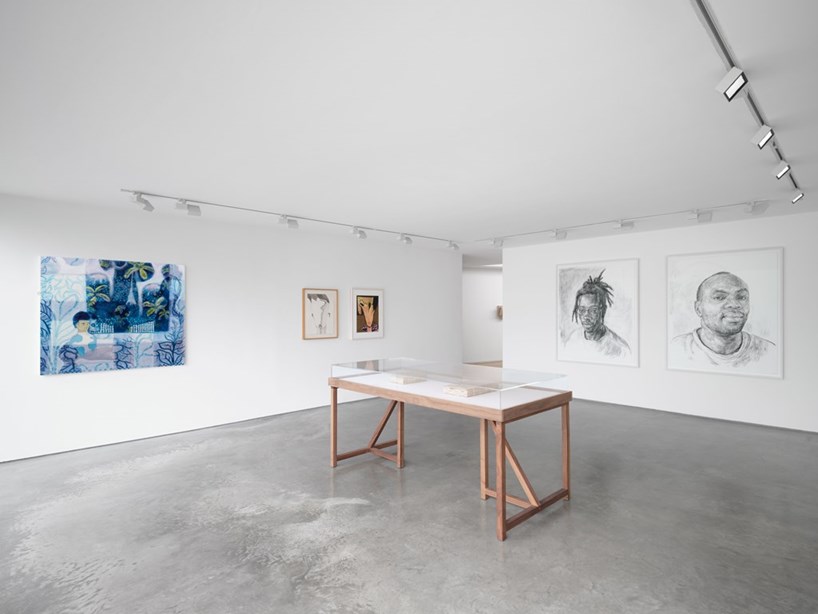THE exhibition “Finding My Blue Sky” is structured as an invitation to imagine your own paradise. The parallel title in Arabic makes this clear: “What is the World that you Dream of?”
Accordingly, the exhibition is a journey of retreat and surrender in search of a sense of longing and belonging — of home, of sacred space — by inviting viewers to participate in the creation of meaning. In the words of its curator, the art-world influencer Omar Kholeif, “‘Finding My Blue Sky’ invites spectators to indulge in the sensuous curve of artistic endeavors that exist in their own culturally situated space of dreaming — one that allows us to sketch myriad possible routes to modernity, and with this, new ways of looking altogether.”
The exhibition uses both London spaces of the Lisson Gallery, as well as its courtyards, windows, and adjacent street corners. We are guided around the spaces by directions such as “Find your wave under the cloud” and “Find your soft landing”. A reflection space is also provided, with deckchairs under olive trees. The images are often hung creatively — high up, low down, climbing the walls diagonally, inside and outside — all to change our perceptions of what they are and what it is they signify.
Kholeif describes one of the works — Shapeshifter (Chilled to the Bone) by the Swiss-Hungarian painter Liliane Tomasko — in terms that extend to the overall project; the work serves “as a seat of multiple desires that are stitched together, unstitched, and re-stitched”. This plurality of approaches and images means that the exhibition is deliberately constructed as a polyphony of voices and visions to which we are metaphorically invited to add our own.
The exhibition brings together more than 20 artists of diverse nationalities and eras whose work Kholeif has journeyed with or, vicariously, through over the years, in order to invoke the voices of these artists and set them in dialogue with others in the exhibition. Such bridging moments are found in the interrelations of works by the Portuguese painter and poet Luísa Correia Pereira and the Lebanese artist Huguette Caland, both of whom feature deconstructed and transfigured images of bodies in their work. These pioneering women are seen in dialogue with the French artist Laure Prouvost, who also revels in transgressive transformations, using her distinctive, playful-heroic register.
 © the artists, courtesy Lisson GalleryExhibition view of “Finding My Blue Sky” at Lisson Gallery, London
© the artists, courtesy Lisson GalleryExhibition view of “Finding My Blue Sky” at Lisson Gallery, London
Pereira was described by some of those who knew her as being like “a God Child”, who “lives in a parallel realm, a reality, beyond death, transmitting cosmic life”. “She lived in the euphoria of games; danced in gestures of lines as if they were ant trails in of piles of graphics that accumulate in the corners of her images” and “was subsumed by the joy of colour”. Such playful exuberance characterises much that is found here, as well as its display.
The Spanish Moroccan painter Anuar Khalifi plays with aspects of Sufi tradition and references from art history in neo-impressionist paintings. His Aqiqah or aqeeqah depicts an Islamic tradition involving the sacrifice of an animal to celebrate the birth of a child and express gratitude to Allah, but in a way that reminds the viewer of depictions of the Trinity. His slaughtered animal references images by Rembrandt, Soutine, and Bacon.
The invisible enemy should not exist is a series in which Michael Rakowitz constructs reappearances of historically looted and recently destroyed artefacts. Included here is The invisible enemy should not exist (Room Z, Northwest Palace of Nimrud) Z-b-1, a reappearance of a relief sculpture that lined the walls of the ancient Assyrian Palace of Nimrud collaged together using Arabic newspapers, food packaging, and cardboard.
In another bridging moment, Soft Ending, an early work by Sean Scully (which stems from a transformative trip to Morocco and his reminiscences of the workers and the structures of the rugs that they made) is coupled with a newly created work, Rabat Blue, which also evokes memories of his Moroccan trips, including the feelings associated with the colours of early morning and midday.
“Finding My Blue Sky” is characterised by many bridging moments and by works of art that channel and conjoin the exhibition’s themes of translation, origin, memory, history, spirituality, and identity.
“Finding My Blue Sky” is at the Lisson Gallery, 27 Bell Street and 67 Lisson Street,
London NW1, until 26 July. Phone 020 7724 2739. www.lissongallery.com
















